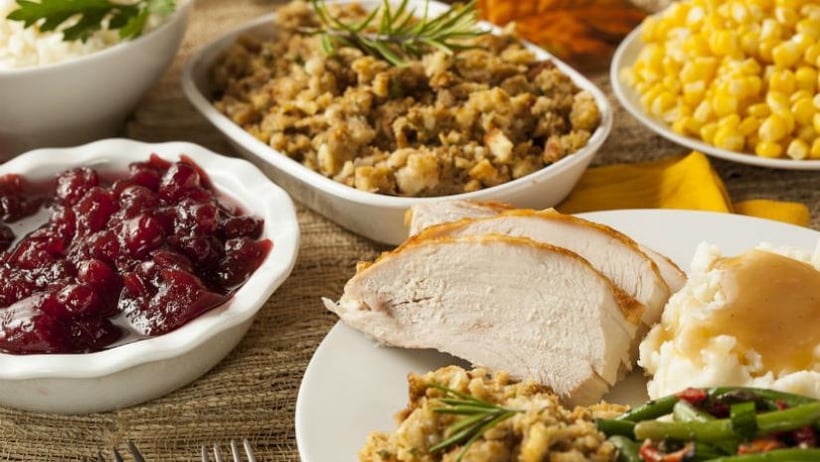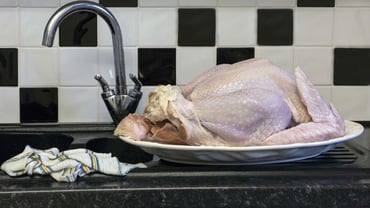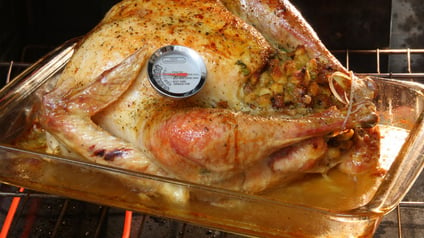
This weekend, the only illness we want your Thanksgiving guests suffering from is a temporary carb, turkey and sugar-induced coma - not food poisoning.
It’s common for food poisoning to rear its ugly face at Thanksgiving dinners. With friends and family transporting dishes, multiple preparation steps and a giant bird you’ve only cooked a handful of times in your life, it’s easy to have a food safety mishap.
But don’t worry, food safety help is here. Avoiding cross-contamination and performing correct time and temperature checks will ensure your food is safe for everyone at your table.
Avoid cross-contamination
 Cross-contamination happens when harmful bacteria or other microorganisms are unintentionally transferred from one substance or object to another.
Cross-contamination happens when harmful bacteria or other microorganisms are unintentionally transferred from one substance or object to another.
One of the easiest ways to spread bacteria is by washing your turkey before preparing it. It’s a common rookie food safety mistake. Washing the turkey makes it easy for bacteria to cover your sink and surfaces.
A few other tips for a Thanksgiving without cross-contamination are:
Prepare your turkey and other potentially hazardous foods (raw eggs, meats and dairy) separate from where you prepare other foods. For example:
John is cracking eggs to make his world-famous pie pastry. Some of the raw egg is dripped on the counter where raw vegetables are later prepared. Bacteria from the raw egg is transferred to raw vegetables in a salad. Anyone who eats the salad is now at risk for food poisoning.
Cleaning your surfaces between preparing different dishes and having cutting boards specific to food types will drastically reduce the spread of bacteria.
Use different utensils when taste testing or preparing foods. For example:
Shada uses a spoon to push stuffing into a raw turkey. Once finished, she tosses the spoon in the sink. Shada’s mom picks that same spoon up later, giving it a quick rinse. She then uses it to taste test her butternut squash soup, putting her in direct contact with bacteria from the raw turkey and contaminating the soup.
Never use the same utensils to prepare multiple dishes. When finished using a utensil, place it immediately in the dishwasher or wash it with hot water and soap, leaving it to air dry.
Store your ingredients in the correct order, with potentially hazardous foods on the bottom shelves. For example:
Gordon thaws his turkey on a middle rack in his fridge. While defrosting overnight, the turkey drips juices into a boxed pumpkin pie stored beneath the thawing turkey. Even though the pie looks safe, it’s crawling with bacteria. One bite of that pie and you’re a victim of food poisoning.
Always thaw your turkey in your fridge but make sure to place it on the bottom shelf. Place it in a roasting pan or on a tray that will catch any raw juice drippings. All other food items in your fridge should be kept in sealed containers.
One of the easiest ways to avoid cross-contamination is handwashing. Although they may look and feel clean, our hands can harbour dangerous bacteria that can easily transfer to the food we’re preparing. To correctly wash your hands, you need to follow (in order) these six steps:
- Wet hands
- Apply liquid soap
- Lather and scrub
- Rinse
- Turn off tap
- Dry hands
Avoid using your apron or a dishtowel to dry your hands. Doing so can transfer back the harmful bacteria you just washed off. Use paper towels, or have a stack of towels that can be tossed in the wash after one use.
Follow correct time and temperature guidelines
Getting your feast on the table is a balancing act. You want your dishes to be piping hot and your guests not sitting at the table with drooling mouths waiting for one last dish to make its entrance. When cooking, transporting, serving and storing food, your best protection from food poisoning is keeping food out of the Temperature Danger Zone (between 4℃ and 60℃, 40°F to 140°F).
Make sure to use the following guidelines when preparing, serving and storing your Thanksgiving feast.
Thaw your turkey in your fridge. Thaw the turkey breast side up. Allow a minimum of 24 hours for a 4-5 pound turkey to thaw. If your turkey is larger, for example, around 16 pounds it will take up to 4 days for it to thaw.
It is not recommended to thaw your turkey using the sink method (under cool running water), and never thaw your turkey on the counter. Not only does that allow microorganisms to multiply rapidly, but it also puts you at risk of spreading germs across the surfaces of your kitchen, increasing the risk of cross-contamination.
If you’re not sure about the temperature of your fridge, purchase a freezer-refrigerator thermometer.

Cook your turkey to an internal temperature of 82℃ / 180℉. To measure the internal temperature, use a properly calibrated probe thermometer. Insert the thermometer into the thickest part of the bird.
Cooking your stuffing inside your turkey is not recommended, juices containing Salmonella may soak into the stuffing. If you do decide to cook your turkey stuffed, use your probe thermometer to check the temperature of the stuffing, which needs to be 74℃ / 165℉.
Don’t have guests travelling long distances deliver potentially hazardous foods. Some examples of potentially hazardous Thanksgiving foods are turkeys, gravies, mashed potatoes, cream pies, whipped creams or dairy toppings.
If everyone is pitching in to bring dinner to the table, make sure your guests are transporting food in properly sealed containers and for no longer than 2 hours.
Whether cooked or uncooked, deadly bacteria loves to breed in potentially hazardous foods that have been sitting in a warm vehicle. If your guests insist on bringing these foods, require that they use coolers with ice or ice packs.
Package, transport and store leftovers correctly. If you’re like most Canadian families, your Thanksgiving dinner will result in leftover meals for days to come. Freeze whatever you think you won’t be able to eat. Leftovers in your fridge should be eaten within three days. Once past the three-day limit, you’re putting yourself at risk.
You can also avoid food poisoning by packaging all leftover foods separately, never store a cooked turkey with the stuffing still in it. Also, before moving any food to the fridge or freezer, make sure it’s cooled to room temperature.
What if the worst happens?
You now know some common Thanksgiving foods that can put you at risk for food poisoning. Taking extra care when handling these foods will avoid the dangers of cross-contamination and preparing, transporting and storing them at the correct temperatures will prevent spoilage. But even when you do your best, accidents can still happen.
Unfortunately, food poisoning is common. In Canada, over 4 million (1 in 8) Canadians will fall victim to food poisoning this year. Common symptoms of food poisoning are abdominal pain, diarrhea and vomiting. It can take up to 48 hours for symptoms to show.
If you or your dinner guests develop food-borne illness, it’s important to seek medical attention immediately. Children, the elderly and pregnant women are especially vulnerable to food-borne illness and likely to experience more severe symptoms.
For more information on handling potentially hazardous foods — including specific rules for purchasing, storing, thawing, preparing, cooking and serving — download the CIFS Guide to Potentially Hazardous Foods.





